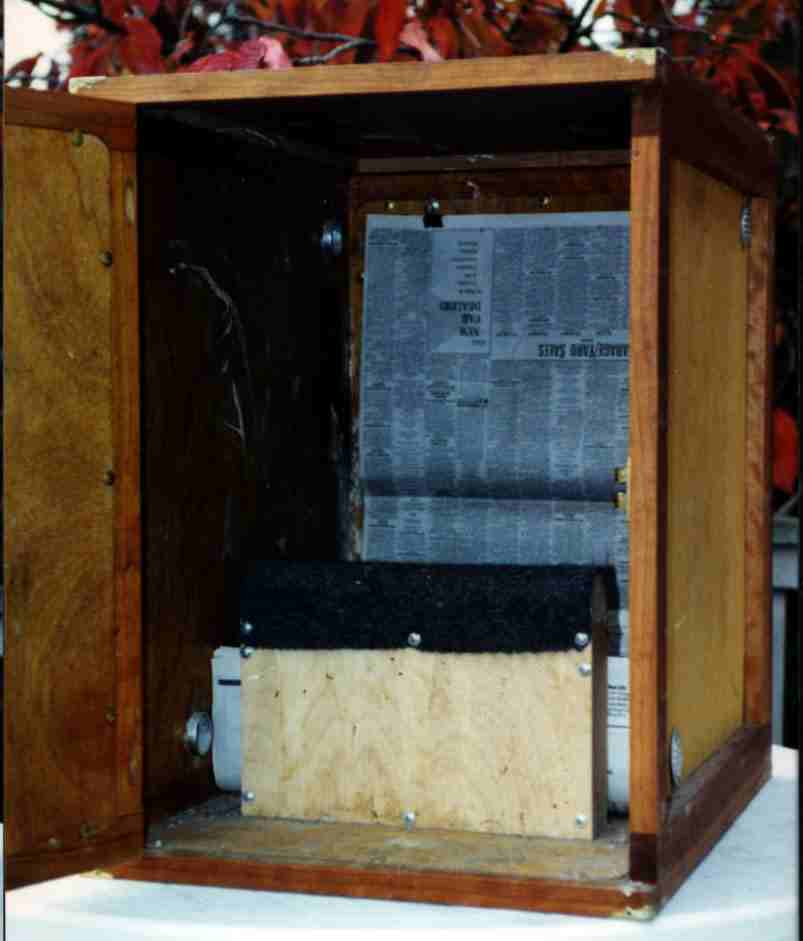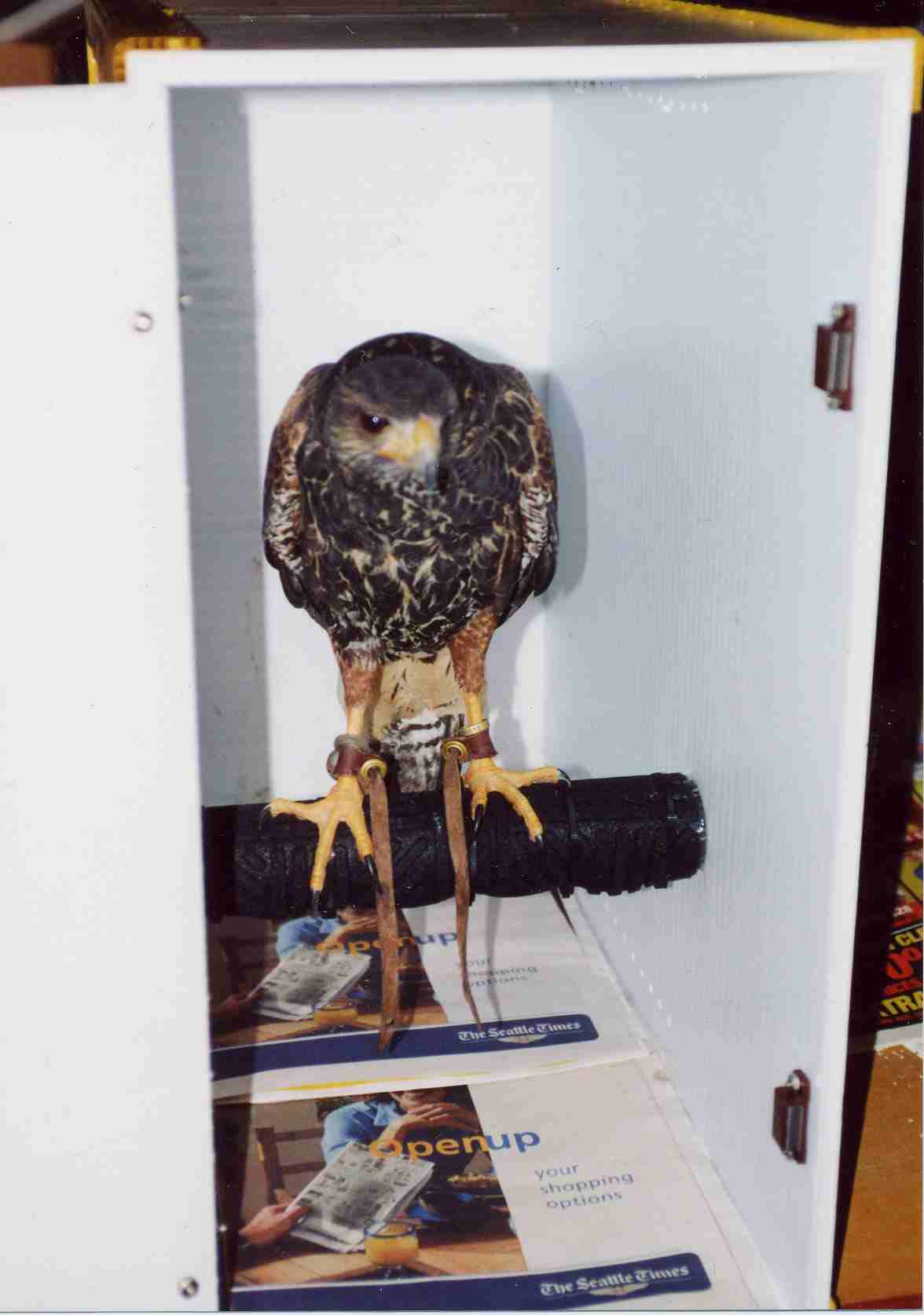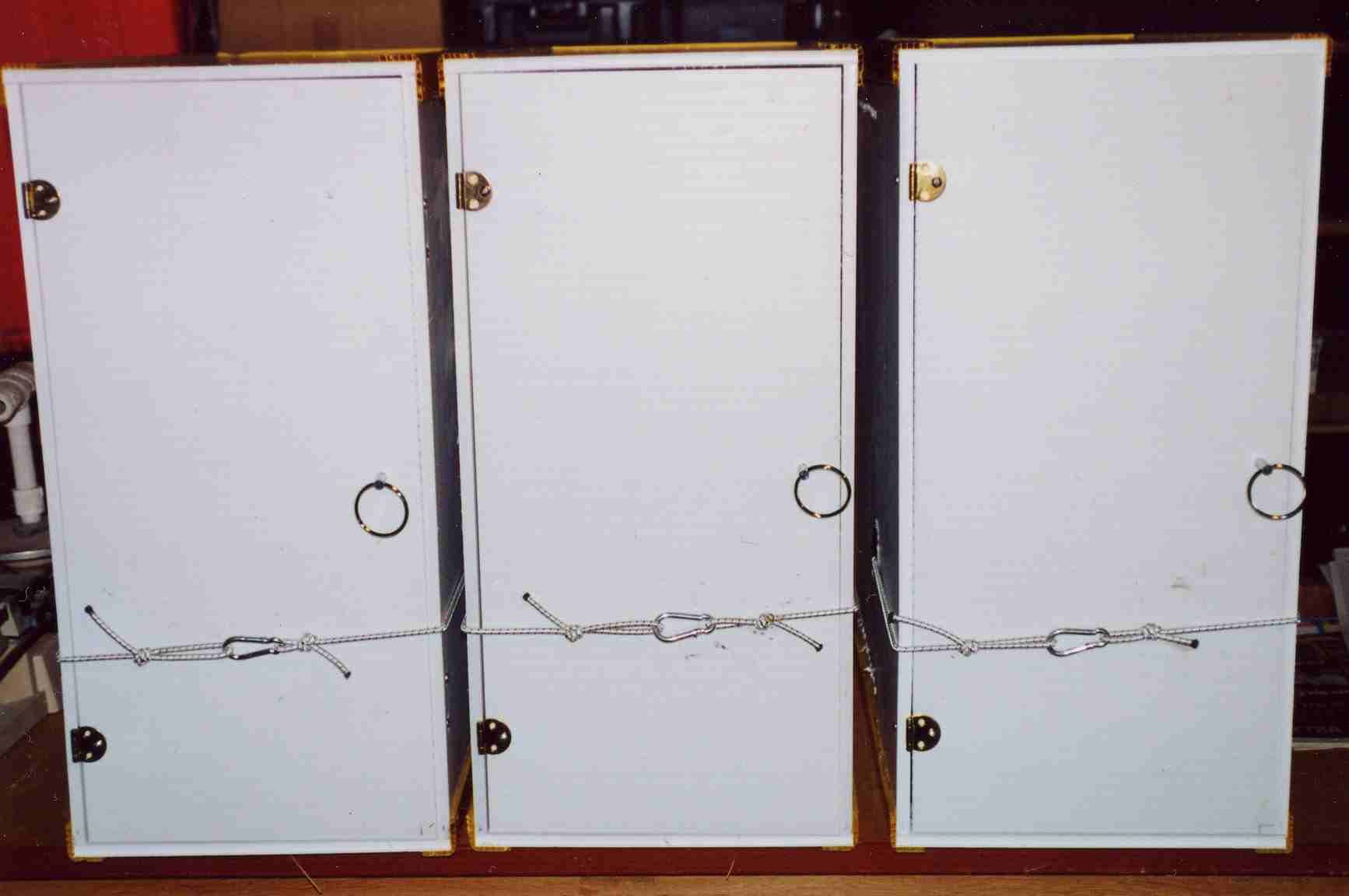Hawk boxes (aka
'giant hoods')
Contact:
Toby Bradshaw <baywingdb@comcast.net>
I like to transport my Harris's hawks
in boxes, sometimes known as 'giant hoods.' Boxes keep the hawks separated
from each other, out of sight of curious onlookers, and prevent slices from
decorating the inside of my vehicle.
 Hawk
boxes can be made of many different materials. At one time I made
cherry-framed birch-paneled wooden boxes (left), but now I make my hawk boxes
from 10mm Coroplast (below). The
10mm Coroplast is light (half the weight of wood), strong enough for my dogs to
stand on, and can be hosed out when it comes time to clean the box. The
ease of sanitation alone is reason enough to use Coroplast. A 4'x8' sheet
of 10mm Coroplast costs about $30, and is enough to make a couple of boxes.
Hawk
boxes can be made of many different materials. At one time I made
cherry-framed birch-paneled wooden boxes (left), but now I make my hawk boxes
from 10mm Coroplast (below). The
10mm Coroplast is light (half the weight of wood), strong enough for my dogs to
stand on, and can be hosed out when it comes time to clean the box. The
ease of sanitation alone is reason enough to use Coroplast. A 4'x8' sheet
of 10mm Coroplast costs about $30, and is enough to make a couple of boxes.
After squaring one corner of the
Coroplast sheet (the factory corners are not square by a long shot!), I cut the sides, top, and bottom to
dimension on a table saw, then join the edges with a 2.25" strip of 4mm Coroplast
(yellow in the photos) kerfed (1/4" wide kerf with 1" of 4mm Coroplast on either
side) halfway through lengthwise to make it easy to bend
around the corners. The 4mm Coroplast is held to the 10mm Coroplast with
Goop glue, a waterproof contact cement.
 Short
sheet metal screws are used to hold the 4mm Coroplast while the Goop dries.
Outside
dimensions of the box are 11.75" wide, 23.5" tall, and 23.5"
deep. This is big enough for either sex of Harris's hawk (the photo on the
right shows a female HH in the box). The 2"
diameter PVC perch, covered with textured rubber floormat, is set into holes cut
into the sides of the box and secured with a bead of Goop on the inside of the
box. The center of the perch should be 7.5" above the floor and 8" from the front of
the box. These dimensions allow the Harris's hawk plenty of head and tail room,
space to lift its tail to slice without touching the back of the box, and fit a sheet of newspaper to catch the slices.
These boxes are narrow enough for me to carry three across the width of
the bed on my Ford Ranger. A tiercel Harris's hawk can turn around in a box
this narrow, but in general I back the birds into the box. I drill 15 1/4"
holes on the top and bottom of each side of the box for ventilation. The
PVC perch has 1/2" holes drilled in the bottom of the pipe to allow for
additional air circulation. VENTILATION IS
CRITICAL TO PREVENT CARBON MONOXIDE POISONING!
Short
sheet metal screws are used to hold the 4mm Coroplast while the Goop dries.
Outside
dimensions of the box are 11.75" wide, 23.5" tall, and 23.5"
deep. This is big enough for either sex of Harris's hawk (the photo on the
right shows a female HH in the box). The 2"
diameter PVC perch, covered with textured rubber floormat, is set into holes cut
into the sides of the box and secured with a bead of Goop on the inside of the
box. The center of the perch should be 7.5" above the floor and 8" from the front of
the box. These dimensions allow the Harris's hawk plenty of head and tail room,
space to lift its tail to slice without touching the back of the box, and fit a sheet of newspaper to catch the slices.
These boxes are narrow enough for me to carry three across the width of
the bed on my Ford Ranger. A tiercel Harris's hawk can turn around in a box
this narrow, but in general I back the birds into the box. I drill 15 1/4"
holes on the top and bottom of each side of the box for ventilation. The
PVC perch has 1/2" holes drilled in the bottom of the pipe to allow for
additional air circulation. VENTILATION IS
CRITICAL TO PREVENT CARBON MONOXIDE POISONING!
 The
door is held with brass cabinet hinges and stainless steel screws. Two
magnetic catches provide a door stop and hold the door closed, but I use a 1/8"
bungee cord wrapped through the PVC perch and fastened with a carabiner as a
fail-safe against unwanted door opening. A door pull is made from a
5/16"x1" clevis pin and a split ring.
The
door is held with brass cabinet hinges and stainless steel screws. Two
magnetic catches provide a door stop and hold the door closed, but I use a 1/8"
bungee cord wrapped through the PVC perch and fastened with a carabiner as a
fail-safe against unwanted door opening. A door pull is made from a
5/16"x1" clevis pin and a split ring.
The 10mm Coroplast is available in
white, which is perfect for keeping the box cool. However, white is fairly
translucent. If you need a completely dark box (not necessary for Harris's
hawks), you may wish to paint the outside black (for opacity) with a white
topcoat (to prevent heat buildup). Coroplast takes paint well since
it is intended to be used as sign material. You can also use black
Coroplast, which is slightly more expensive than white.
My hawks spend a lot of time in their
boxes, so I have gone out of my way to construct them well. They still
look good after years of very hard use. The bloodstains on them do not
detract from their appearance; they are badges of honor!
Back to Toby Bradshaw's
Hawking and Falconry Website.
For more information, contact
Toby
Bradshaw.
Last revised: 8-Jan-2005
 Hawk
boxes can be made of many different materials. At one time I made
cherry-framed birch-paneled wooden boxes (left), but now I make my hawk boxes
from 10mm Coroplast (below). The
10mm Coroplast is light (half the weight of wood), strong enough for my dogs to
stand on, and can be hosed out when it comes time to clean the box. The
ease of sanitation alone is reason enough to use Coroplast. A 4'x8' sheet
of 10mm Coroplast costs about $30, and is enough to make a couple of boxes.
Hawk
boxes can be made of many different materials. At one time I made
cherry-framed birch-paneled wooden boxes (left), but now I make my hawk boxes
from 10mm Coroplast (below). The
10mm Coroplast is light (half the weight of wood), strong enough for my dogs to
stand on, and can be hosed out when it comes time to clean the box. The
ease of sanitation alone is reason enough to use Coroplast. A 4'x8' sheet
of 10mm Coroplast costs about $30, and is enough to make a couple of boxes. Short
sheet metal screws are used to hold the 4mm Coroplast while the Goop dries.
Outside
dimensions of the box are 11.75" wide, 23.5" tall, and 23.5"
deep. This is big enough for either sex of Harris's hawk (the photo on the
right shows a female HH in the box). The 2"
diameter PVC perch, covered with textured rubber floormat, is set into holes cut
into the sides of the box and secured with a bead of Goop on the inside of the
box. The center of the perch should be 7.5" above the floor and 8" from the front of
the box. These dimensions allow the Harris's hawk plenty of head and tail room,
space to lift its tail to slice without touching the back of the box, and fit a sheet of newspaper to catch the slices.
These boxes are narrow enough for me to carry three across the width of
the bed on my Ford Ranger. A tiercel Harris's hawk can turn around in a box
this narrow, but in general I back the birds into the box. I drill 15 1/4"
holes on the top and bottom of each side of the box for ventilation. The
PVC perch has 1/2" holes drilled in the bottom of the pipe to allow for
additional air circulation. VENTILATION IS
CRITICAL TO PREVENT CARBON MONOXIDE POISONING!
Short
sheet metal screws are used to hold the 4mm Coroplast while the Goop dries.
Outside
dimensions of the box are 11.75" wide, 23.5" tall, and 23.5"
deep. This is big enough for either sex of Harris's hawk (the photo on the
right shows a female HH in the box). The 2"
diameter PVC perch, covered with textured rubber floormat, is set into holes cut
into the sides of the box and secured with a bead of Goop on the inside of the
box. The center of the perch should be 7.5" above the floor and 8" from the front of
the box. These dimensions allow the Harris's hawk plenty of head and tail room,
space to lift its tail to slice without touching the back of the box, and fit a sheet of newspaper to catch the slices.
These boxes are narrow enough for me to carry three across the width of
the bed on my Ford Ranger. A tiercel Harris's hawk can turn around in a box
this narrow, but in general I back the birds into the box. I drill 15 1/4"
holes on the top and bottom of each side of the box for ventilation. The
PVC perch has 1/2" holes drilled in the bottom of the pipe to allow for
additional air circulation. VENTILATION IS
CRITICAL TO PREVENT CARBON MONOXIDE POISONING! The
door is held with brass cabinet hinges and stainless steel screws. Two
magnetic catches provide a door stop and hold the door closed, but I use a 1/8"
bungee cord wrapped through the PVC perch and fastened with a carabiner as a
fail-safe against unwanted door opening. A door pull is made from a
5/16"x1" clevis pin and a split ring.
The
door is held with brass cabinet hinges and stainless steel screws. Two
magnetic catches provide a door stop and hold the door closed, but I use a 1/8"
bungee cord wrapped through the PVC perch and fastened with a carabiner as a
fail-safe against unwanted door opening. A door pull is made from a
5/16"x1" clevis pin and a split ring.